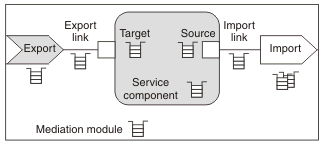IBM BPM, V8.0.1, All platforms > Administer applications and processes in the runtime environment > Administer service applications and service modules
Resources for service modules
Service modules use resources provided by the service integration technologies of WebSphere Application Server. Service modules can also make use of a range of resources, including those provided by the Java™ Message Service (JMS) and Common Event Infrastructure. To administer the resources for service modules, you can use the WebSphere administrative console, commands, and scripting tools.
For more information about managing resources for service modules, see the related topics.
JNDI resources must not be shared across clusters. A cross-cluster module requires that each cluster have different JNDI resources. See Considerations for deploying service applications on clusters.
Service integration technologies
Service integration resources, such as bus destinations, enable a service module to use service integration technologies. Queue destinations are used by the SCA run time exploited by the service module as a robust infrastructure to support asynchronous interactions between components and modules. When install a service module into IBM BPM, the destinations used by a module are defined on a member of the SCA.SYSTEM bus. These bus destinations are used to hold messages that are being processed for components of the service module that use asynchronous interactions:
- Queue sca/ module_name
- This is the destination used to buffer asynchronous requests sent to module module_name
- Queue sca/ module_name/exportlink/ export_name
- This is the destination used by the export to send asynchronous requests to the module. Requests are routed to the component target linked to the export.
- Queue sca/ module_name/importlink/ import_name
- This is the destination used by the import to send asynchronous requests out of the module. Requests are routed to the module export linked to the import.
- Queue sca/ module_name/import/sca/dynamic/import/scaimport [for SCA binding]
- Queue sca/ module_name/import/sca/dynamic/import/wsimport [for Web service binding]
- Queue sca/contextStore/ module_name

For each of the destinations, a queue point is also created and defined on the messaging engine of the relevant bus member.
You can deploy and use service modules without needing to manage these resources. However, you might want to adjust the configuration of the resources (for example, to modify the maximum messaging quality of service used) or to use them in locating messages for troubleshooting.
Java Message Service (JMS)
JMS resources enable a service module to use asynchronous messaging as a method of communication based on the Java Message Service (JMS) programming interface. The JMS support used depends on the JMS binding of the module.
For example, a module with a JMS binding uses a JMS connection factory configured on the default messaging provider provided by the underlying WebSphere Application Server, while a module with a WebSphere MQ JMS binding uses a JMS connection factory configured on WebSphere MQ as the JMS provider. To manage use of the Java Message Service, you can administer the following resources:
- JMS connection factory
- A JMS connection factory is used to create connections to the associated JMS provider of JMS destinations, for both point-to-point and publish/subscribe messaging. Use connection factory administrative objects to manage JMS connection factories for the provider.
- JMS queue
- A JMS queue is used as a destination for point-to-point messaging. Use JMS queue destination administrative objects to manage JMS queues for the provider.
- JMS topic
- A JMS topic is used as a destination for publish/subscribe messaging. Use topic destination administrative objects to manage JMS topics for the provider.
- JMS activation specification
- A JMS activation specification is associated with one or more message-driven beans and provides the configuration necessary for them to receive messages.
- JMS listener port
- A JMS listener port defines the association between a connection factory, a destination, and a message-driven bean. This enables deployed message-driven beans associated with the port to retrieve messages from the destination.
Common Event Infrastructure (CEI)
CEI resources enable a service module to use standard formats and mechanisms for managing event data. To manage use of the Common Event Infrastructure, you can administer the following resources:
- Data Store Profile
- This profile defines properties used by the default data store. The default data store is the data store supplied by the Common Event Infrastructure.
- Emitter Factory Profile
- This profile defines the options for an event emitter.
- Event Bus Transmission Profile
- This profile defines the EJB entry into the event bus.
- Event Group Profile
- This profile defines a list of events which are determined through selector expressions. JMS queues and a JMS topic can be associated with each event group. If the event server distribution service is enabled and an event matches an event group the event is distributed to any topic or queues configured for that particular event group.
- Event Server Profile
- This profile defines the properties for the event server.
- Filter Factory Profile
- This profile defines the properties of a filter. The filter uses the filter configuration string to determine whether an event will be passed to the bus.
- JMS Transmission Profile
- This profile defines a JMS queue entry into the event bus. It defines the JNDI names for a JMS queue and queue connection factory.